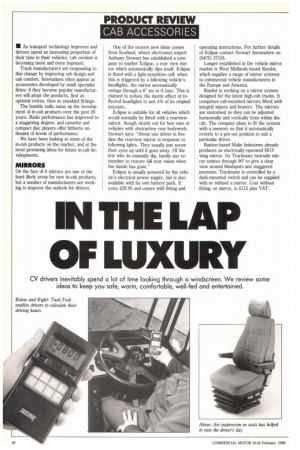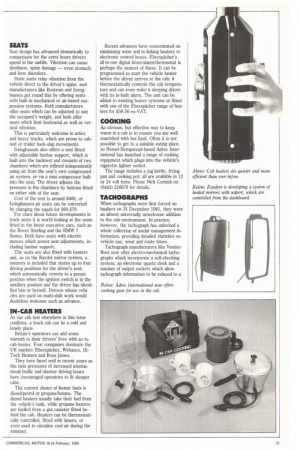PRODUCT REVIEW CAB ACCESSORIES
Page 34

Page 35

Page 36

If you've noticed an error in this article please click here to report it so we can fix it.
• As transport technology improves and drivers spend an increasing proportion of their time in their vehicles, cab comfort is becoming more and more impotant.
Truck manufacturers are responding to this change by improving cab design and cab comfort. Innovations often appear as accessories developed by small specialist firms: if they become popular manufacturers will adopt the products, first as optional extras, then as standard fittings.
The humble radio sums up the development of in-cab products over the past 20 years. Radio performance has improved to a staggering degree, and cassette and compact disc players offer hitherto undreamt of levels of performance.
We have been looking at some of the in-cab products on the market, and at the most promising ideas for future in-cab developments.
On the face of it mirrors are one of the least likely areas for new in-cab products, but a number of manufacturers are working to improve the outlook for drivers. One of the neatest new ideas comes from Scotland, where electronics expert Anthony Stewart has established a company to market Eclipse, a rear view mirror which automatically dips itself. Eclipse is fitted with a light-senstitive cell: when this is triggered by a following vehicle's headlights, the mirror automatically swings through a 6° arc in 0.1sec. This is claimed to reduce the dazzle effect of reflected headlights to just 4% of its original intensity.
Eclipse is suitable for all vehicles which would normally be fitted with a rearview mirror, though clearly not for box vans or vehicles with obstructive rear bodywork. Stewart says: "About one driver in five dips the rearview mirror in response to following lights. They usually just screw their eyes up until it goes away. Of the few who do manually dip, hardly any remember to restore full rear vision when the dazzle has gone," Eclipse is usually powered by the vehicle's electrical power supply, but is also available with its own battery pack. It costs 229.95 and comes with fitting and operating instructions. For further details of Eclipse contact Stewart Automotive on (0475) 37191.
Longer established in the vehicle mirror market is West Midlands-based Raydot, which supplies a range of mirror systems to commercial vehicle manufacturers in the Europe and America.
Raydot is working on a mirror system designed for the latest high-cab trucks. It comprises cab-mounted mirrors fitted with integral wipers and heaters. The mirrors are motorised so they can be adjusted horizontally and vertically from within the cab. The company plans to fit the system with a memory so that it automatically reverts to a pre-set position to suit a particular driver.
Buxton-based Malin Industries already produces an electrically-operated HGV wing mirror. Its Truclunate nearside mirror rotates through 90° to give a clear view around blindspots and staggered junctions. Truckmate is controlled by a dash-mounted switch and can be supplied with or without a mirror. Cost without fitting, or mirror, is £115 plus VAT. Seat design has advanced dramatically to compensate for the extra hours drivers spend in the saddle. Vibration can cause tiredness, spine damage — even stomach and liver disorders.
Static seats relay vibration from the vehicle direct to the driver's spine; seat manufacturers like Bostrom and Isringhausen get round this by offering seats with built-in mechanical or air-based suspension systems. Both manufacturers offer seats which can be adjusted to suit the occupant's weight, and both offer seats which limit horizontal as well as vertical vibration.
This is particularly welcome in artics and heavy trucks, which are prone to cabnod or trailer back-slap movements.
Isringhausen also offers a seat fitted with adjustable lumbar support, which is built into the backrest and consists of two chambers which are inflated independently using air from the seat's own compressed air system, or via a mini compressor built into the seat. The driver adjusts the pressure in the chambers by buttons fitted on either side of the seat.
Cost of the seat is around £400, or Isringhausen air seats can be converted by changing the squab for £60-£70.
For clues about future developments in truck seats it is worth looking at the seats fitted in the latest executive cars, such as the Rover Sterling and the BMW 7 Series. Both have seats with electric motors which power seat adjustments, including lumbar support.
The seats are also fitted with heaters and, as on the Raydot mirror system, a memory is included that stores up to four driving positions for the driver's seat, which automatically reverts to a preset position when the ignition switch is in the auxiliary position and the driver has identified him or herself. Drivers whose vehicles are used on multi-shift work would doubtless welcome such an advance.
As our cab test elsewhere in this issue confirms, a truck cab can be a cold and lonely place_ Britain's operators can add some warmth to their drivers' lives with an incab heater. Four companies dominate the UK market: Eberspacher, Webasco, HiTech Heaters and Ross James.
They have fared well in recent years as the twin pressures of increased international traffic and shorter driving hours have encouraged operators to fit sleeper cabs.
The current choice of heater fuels is diesel/petrol or propane/butane. The diesel heaters usually take their fuel from the vehicle's tank, while propane heaters are fuelled from a gas canister fitted behind the cab. Heaters can be thermostatically controlled, fitted with timers, or even used to circulate cool air during the summer. Recent advances have concentrated on minimising noise and in linking heaters to electronic control boxes. Eberspacher's all-in-one digital timer/alarm/thermostat is perhaps the neatest of these. It can be programmed to start the vehicle heater before the driver arrives at the cab; it thermostatically controls the cab temperature and can even wake a sleeping driver with its in-built alarm. The unit can be added to existing heater systems or fitted with one of the Eberspacher range of heaters for £59.50 ex-VAT.
An obvious, but effective way to keep warm in a cab is to ensure you are well nourished with hot food. Often it is not possible to get to a suitable eating place, so Hemel-Hempstead-based Adrec International has launched a range of cooking equipment which plugs into the vehicle's cigarette lighter socket.
The range includes a jug kettle, frying pan and cooking pot; all are available in 12 or 24 volt form. Phone Nick Cornish on (0442) 216678 for details.
When tachographs were first forced on hauliers on 31 December 1981, they were an almost universally unwelcome addition to the cab environment. In practice, however, the tachograph has unlocked a whole collection of useful management information, providing detailed statistics on vehicle use, wear and route times.
Tachograph manufacturers like VeederRoot now offer electro-mechanical tachographs which incorporate a self-checking system, an electronic quartz clock and a number of output sockets which allow tachograph information to be relayed to a personal computer for analysis without recourse to the tachograph chart.
Government legislation prohibits electronic tachographs. Foden's electronic dash, first seen in this country last year at Tankcon, could be used to provide all the tachograph information currently required — and detailed information on vehicle performance including fuel consumption. It can also serve as a speed limiter. Ironically, an industry which was once so loathe to accept tachographs is now stymied by outdated Government controls.
One neat innovation which is used in conjuction with a tachograph, but which could be incorporated in an electronic tachograph, is the Tach: Trak which allows drivers accurately to calculate their driving hours.
The driver simply programmes the pocket-calculator-sized instrument with the details of his working day, including rest periods. Tacit Trak automatically sounds an alarm 15 minutes before the end of a permitted driving period.
Tach: Trak operates on three pen-light batteries which are claimed to give at least 12 months' service; it also incorporates a seven-day memory so it can warn a driver of weekly, as well as daily, hours or rest offences.
The makers claim that its the major benefit is in optimising vehicle usage because drivers can accurately forecast how much driving time they have left. Tach: Trak is said to be in use with 15,000 drivers; it costs around £42 from Iveco Ford dealers.
Developments in radio and audio technology offer ever-improving radio, cassette and now compact disc — generated sound in the vehicle.
Pioneer, Philips, Panasonic and Alpine all offer compact disc players for in-vehicle use. Prices are still at a level which takes the breath away, but they should not be written off as too delicate for CV use.
With the high price of compact discs and players, Alpine's 5950 Remote Changer addresses itself to the problem of thefts from cabs. It consists of a control unit which fits in the cab, and a remote changer unit which can be positioned in a more secure place on the vehicle. The two units are connected by digital cable. Up to 12 discs are played in the changer, and the music from these is relayed via the cable to the in-cab speakers. The choice of disc is made through the control unit, and with a choice of 12 discs there is potential for up to 18 hour's continuous music. . . at a cool price of £1,150.
Less ambitious are the latest anti-theft devices incorporated in vehicle radiocassette players from Sharp and Philips.
Sharp has incorporated a system called Sharp Guard into two of its models. Sharp Guard requires an additional connection to the vehicle's electrical system to lock the unit into the dashboard while the vehicle's ignition is off, using a metal plate which moves out to cover the unit's removal pin holes. Sharp claims this makes a protected unit virtually impossible to remove: the two units cost £110 and £160.
Philips has two different approaches to beating stereo thieves; a retractable unit, which could prove impractical for most commercial vehicles, and a security code which is featured in its DC680 unit.
The security code is a three-figure number chosen by the driver and programmed into the unit. If the DC680 is disconnected from its power source, as it would be during an attempted theft, it automatically cuts out and will not resume operation until the correct code is entered. The DC680 costs £179.99.
Both this system and Sharp's Sharp Guard system come complete with conspicuous window stickers designed to warn thieves of the difficulties they will face if they try to steal the unit.
As electronics and communications technology improves we are bound to see many in-cab products linked, with control for all the systems from a simple keyboard or touch-sensitive screen. The technology is here now: the truck manufacturers need only to be encouraged to bring these improvements to the drivers' working place.
by Richard Scrase
























































































